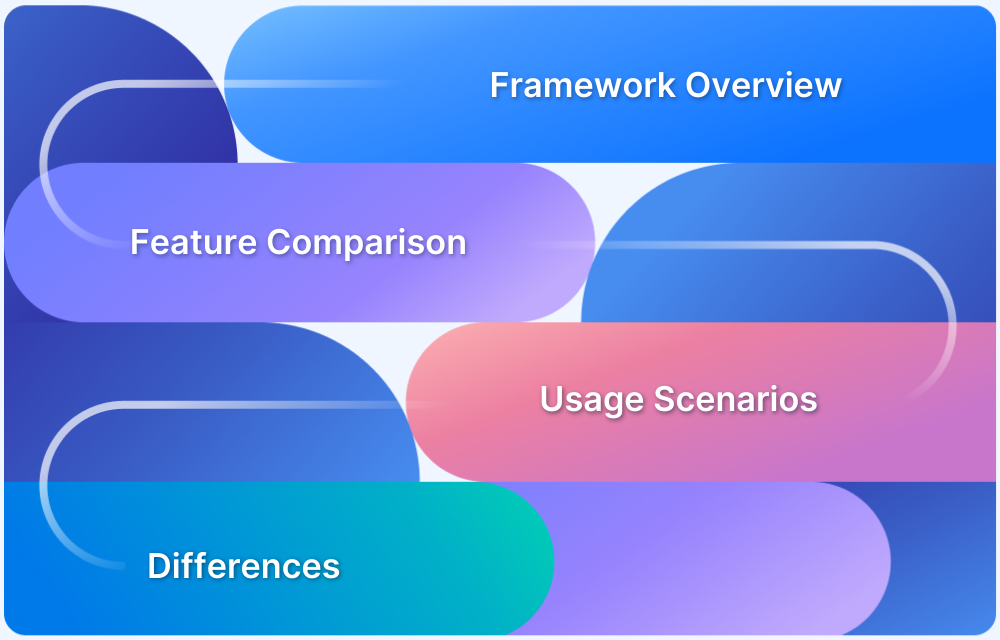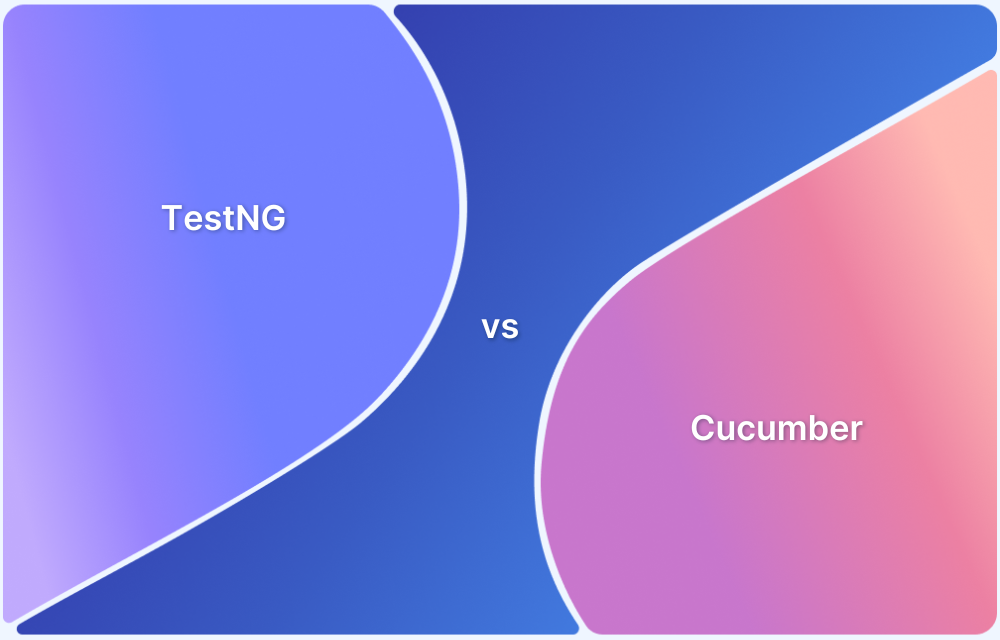JUnit and TestNG are popular testing frameworks used in Java for writing and running unit tests.
Overview
What is JUnit
JUnit is an open-source framework that is part of the xUnit family, designed specifically for unit testing in Java. It is simple, easy to use, and integrates well with many IDEs and build tools.
What is TestNG
TestNG is a powerful and flexible framework inspired by JUnit, and designed to overcome some of its limitations. It supports advanced features like parallel testing, data-driven testing, and test configuration.
JUnit vs TestNG: Main Differences
- Annotations: JUnit uses basic annotations; TestNG offers more advanced ones.
- Parameterization: JUnit has limited support; TestNG supports it via @DataProvider.
- Parallel Testing: Not built-in in JUnit; TestNG supports it natively.
- Suite Execution: JUnit needs external setup; TestNG supports XML-based suites easily.
This article analyzes JUnit and TestNG and dives deep to compare and understand the differences.
What is JUnit?
JUnit is an open-source unit testing framework for Java. As the name suggests, it is used to test small code units. It is a part of the xUnit architecture. This framework is used by default by Java developers to write as well as execute test cases.
JUnit follows the approach of “testing first then coding”. This emphasizes setting up test data and testing the small piece of code first and then implementing the same. This increases productivity and helps in improving code stability. JUnit 5 is the latest version of JUnit, with the current release being 5.7.1.
Features of JUnit
Here are the features of JUnit:
- Open-Source: JUnit is an open-source framework that helps developers write and test code quickly, enhancing code quality.
- Annotations: It offers a variety of test annotations (e.g., @Test, @BeforeEach) to mark and organize test methods.
- Assertions: JUnit provides built-in assertions to verify expected outcomes in tests (e.g., assertEquals, assertTrue).
- Test Runners: It includes test runners that execute test cases and report results automatically.
- Automation & Feedback: Tests run automatically and provide instant feedback to developers, helping catch issues early.
- Debugging Support: JUnit supports debugging, allowing developers to quickly identify and fix issues during test development.
- Latest Version: The latest version, JUnit 5, is designed to leverage features of Java 8 and above, offering more modularity and flexibility.
Test Setup of JUnit
1. Installing and Setting Up
- JUnit requires Java Version 8 and above.
- Download Java from here
- Download JUnit 5 jars (for Java project) from here
- Open your project and add these external jars through the build path configuration.
- Set up environment variables.
- Add the below dependency in pom.xml for running JUnit tests.
<dependencies> <dependency> <groupId>org.junit.jupiter</groupId> <artifactId>junit-jupiter-engine</artifactId> <version>5.7.1</version> <scope>test</scope> </dependency> <dependency> <groupId>org.junit.platform</groupId> <artifactId>junit-platform-runner</artifactId> <version>5.7.1</version> <scope>test</scope> </dependency> <dependency> <groupId>org.junit.jupiter</groupId> <artifactId>junit-jupiter-api</artifactId> <version>5.7.1</version> <scope>test</scope> </dependency> </dependencies>
2. Test Suites
The test suite consists of a collection of test cases that lets you run the test cases simultaneously. It’s like a logical grouping of test cases.
JUnit 5 uses @RunWith and @Suite Classes for creating Test Suites.
@RunWith(Suite.class)
@Suite.SuiteClasses({
JUnitTestSuiteDemo1.class,
JUnitTestSuitDemo2.class
})
3. Test Annotations
JUnit 5 is an annotation-based framework. Annotations are tags that provide additional information about the test methods or the class. They are usually represented by ‘@’.
Some popular annotations of JUnit 5 include:
- @Test – The MAIN business logic of a program resides here.
- @BeforeAll – Executes before the first test method of the class runs
- @AfterAll – Executes after all the test methods of the current class runs
- @BeforeEach – Executes before each test method
- @AfterEach – Executes after each test method
4. Exceptions Handling
Exception handling is done via Assertions.assertThrows() API. assertThrows() method asserts that the code throws an exception of the given type when executed. This method fails if there is no exception or exception of some other type.
@Test
void testExpectedException() {
Assertions.assertThrows(NumberFormatException.class, () -> {
Integer.parseInt("Hello World"); //would fail since input is not a valid number
});
}
5. Ignoring Tests
Ignoring tests is important in an automation framework since some test cases can become redundant due to changed requirements or may have to be avoided for some reason. This can be done using @Ignore in JUnit 5.
@Ignore
public void oldTest(){
System.out.println("This test to be ignored");
}
@Test
public void newTest(){
System.out.println("Test has been executed");
}
6. Grouping Tests
Grouping tests help in identifying the tests and executing them quickly. JUnit 5 uses @Tag to group the tests.
@Test
@Tag("Smoke")
public void Test_a(){
System.out.println("Testa has been executed");
}
@Test
@Tag("Smoke")
public void Test_b(){
System.out.println("Testb has been executed");
}7. Parameterizing Tests
Parameterizing Tests helps test the same test scenario with different sets of inputs. In JUnit 5, the following dependency needs to be added to parameterize the tests along with @ParameterizedTest.
<dependency>
<groupId>org.junit.jupiter</groupId>
<artifactId>junit-jupiter-params</artifactId>
<version>5.7.1</version>
<scope>test</scope>
</dependency>
@ParameterizedTest
@ValueSource(ints = {1, 3, 5, -3, 15, Integer.MAX_VALUE}) // six numbers
void isOdd_ShouldReturnTrueForOdd(int num) {
assertTrue(Numbers.isOdd(num));
}
Writing JUnit Test cases
A simple JUnit test case will look something like this.
import org.junit.jupiter.api.AfterAll;
import org.junit.jupiter.api.AfterEach;
import org.junit.jupiter.api.Assertions;
import org.junit.jupiter.api.BeforeAll;
import org.junit.jupiter.api.BeforeEach;
import org.junit.jupiter.api.Disabled;
import org.junit.jupiter.api.Tag;
import org.junit.jupiter.api.Test;
import com.howtodoinjava.junit5.examples.Calculator;
public class DemoApp {
@BeforeAll
static void setupFirst(){
System.out.println("@BeforeAll executed");
}
@BeforeEach
void setupSecond(){
System.out.println("@BeforeEach executed");
}
@Tag("DEV")
@Test
void testCalculatorOne()
{
System.out.println("======TEST ONE ADD EXECUTED=======");
Assertions.assertEquals( 8 , Calculator.add(4, 4));
}
@Tag("PROD")
@Disabled
@Test
void testCalculatorTwo()
{
System.out.println("======TEST TWO ADD EXECUTED=======");
Assertions.assertEquals( 10 , Calculator.add(6, 4));
}
@AfterEach
void tearThis(){
System.out.println("@AfterEach executed");
}
@AfterAll
static void tear(){
System.out.println("@AfterAll executed");
}
}
What is TestNG?
TestNG is a Java-based test automation framework that was inspired by JUnit. It overcomes all the limitations of JUnit along with additional functionalities. This makes it more powerful and easier to use. NG here stands for “Next Generation”.
It is designed to cover a range of test categories such as Unit testing, Functional testing, Integration testing, etc. It is extremely popular and helps testers organize the test cases in a structured way. This helps in maintaining the readability of the scripts. The current version of TestNG is 7.6.0.
Features of TestNG
Here’s a look into the features of TestNG:
- Open-Source: TestNG is an open-source testing framework, freely available for use and customization.
- Java Integration: It makes extensive use of advanced Java features, enhancing flexibility and performance.
- Annotations: TestNG supports multiple @Before and @After annotations for detailed test configuration (e.g., @BeforeSuite, @AfterClass).
- XML Configuration: Tests can be configured and organized through XML files, making suite management easier.
- Parameterization: TestNG allows parameterized testing using XML or @DataProvider, enabling dynamic test input.
- Multithreading: It supports multi-threaded test execution for faster test runs.
- Data-Driven Testing: Allows testing with multiple sets of data through features like @DataProvider.
- Report Generation: Automatically generates detailed HTML and XML reports for test execution results.
- Open APIs: Provides publicly available APIs, enabling integration with other tools and custom extensions.
- Parallel Execution: Supports parallel test execution, improving testing efficiency in large projects.
Test Setup of TestNG
1. Installing and setting up
- Download Java from here
- Download TestNG jar (for Java project) from here
- Open your project and add these external jars through Build path configuration.
- Add the below dependency in pom.xml for running TestNG tests.
<dependency> <groupId>org.TestNG</groupId> <artifactId>TestNG</artifactId> <version>7.6.0</version> <scope>test</scope> </dependency>
2. Test Suites
In TestNG, Test Suites are defined in an XML file.
<?xml version="1.0" encoding="UTF-8"?> <!DOCTYPE suite SYSTEM "http://TestNG.org/TestNG-1.0.dtd"> <suite name="TestSuite" parallel="tests"> <test name="DemoTest"> <classes> <class name="com.pages.LoginPageTest"></class> <class name="com.pages.HomePageTest"></class> <class name="com.pages.ProductPageTest"></class> </classes> </test> </suite>
3. Test Annotations
Some popular annotations of TestNG include:
- @Test – MAIN program logic place
- @BeforeClass – Executes before the first test method of the class
- @AfterClass – Executes after all the test methods of the current class
- @BeforeMethod – Executes before each test method
- @AfterMethod – Executes after each test method
4. Exceptions Handling
Exception handling is done via the expectedExceptions parameter along with @Test annotation.
@Test(expectedExceptions = ArithmeticException.class)
public void DivideByZeroTest() {
int i = 20/0;
}
5. Ignoring Tests
Ignoring tests can be done by passing a parameter in the @Test method.
@Test
public void test1() {
System.out.println("This is test1");
}
@Test(enabled = false)
public void test2() {
System.out.println("This is test2");
}
6.Grouping Tests
Grouping tests can be done by passing parameters in the @Test method.
@Test(groups = { "Sanity", "Regression" })
public void test_method1()
{
//Test implementation
}
7. Parameterizing Tests
Parameterizing tests are done by @Parameters. The parameter value is passed in the TestNG XML file.
@Test()
@Parameters("username")
public void test1(String username) {
System.out.println("The username "+username + " is passed");
}
<test name="DemoTest">
<parameter name = "username" value = "Alex"/>
Parameterizing tests can also be done by @DataProviders. It enables multiple input values to test.
@Test(dataProvider = "credentials")
Writing TestNG Test cases
A simple TestNG test case will look something like this.
package newtest.com;
import org.testng.annotations.Test;
import org.testng.annotations.BeforeMethod;
import org.testng.annotations.AfterMethod;
import org.testng.annotations.DataProvider;
import org.testng.annotations.BeforeClass;
import org.testng.annotations.AfterClass;
import org.testng.annotations.BeforeTest;
import org.testng.annotations.AfterTest;
import org.testng.annotations.BeforeSuite;
import org.testng.annotations.AfterSuite;
public class NewTestng {
@Test(dataProvider = "dp")
public void f(Integer n, String s) {
System.out.println(" *Parameterized method*");
System.out.println("Integer "+n+" String "+s);
}
@BeforeMethod
public void beforeMethod() {
System.out.println("Before Method");
}
@AfterMethod
public void afterMethod() {
System.out.println("After Method");
}
@DataProvider
public Object[][] dp() {
return new Object[][] {
new Object[] { 1, "a" },
new Object[] { 2, "b"},
};
}
@BeforeClass
public void beforeClass() {
System.out.println("Before Class");
}
@AfterClass
public void afterClass() {
System.out.println("After Class");
}
@BeforeTest
public void beforeTest() {
System.out.println("Before Test");
}
@AfterTest
public void afterTest() {
System.out.println("After Test");
}
@BeforeSuite
public void beforeSuite() {
System.out.println("Before Suite");
}
@AfterSuite
public void afterSuite() {
System.out.println("After Suite");
}
}
JUnit vs TestNG: Core Differences
Here is the tabular comparison between JUnit and TestNG:
| Criteria | JUnit | TestNG |
|---|---|---|
| Framework | Open Source Testing framework | Open Source Java-based Testing framework |
| Supported Testing | Unit Testing | Unit Testing, Functional Testing, Integration Testing, end-to-end Testing, etc. |
| Annotations | Do not support advanced annotation like @BeforeGroups, @AfterGroups | Supports advanced and unique annotations like @BeforeGroups, @AfterGroups |
| Test Suite | Uses @RunWith, @Suite to run the test suite | Uses an XML file to run the test suite |
| Dependency Tests | Missing Dependency tests | Supports Dependency Tests |
| Grouping Tests | Does not provide Grouping of test cases together | Allows Grouping and executing of test cases together |
| Order of Tests | Does not support | Supports ordering of test methods via a priority attribute |
| Assumptions | Supports Assumptions to skip tests based on certain conditions | Does not support Assumptions |
| Custom Name | Provides provision for Custom descriptive names for tests | Does not provide Custom names |
| Reporting | Integrates with Maven to generate HTML reports | Has built-in HTML reports |
| Listeners | Supports listeners through Listeners API | Supports listeners through annotations |
| Ease of use | Running tests requires a certain amount of dependency Eg. for parameterization, one might need JUnit Jupiter | Writing and running tests is very easy |
Conclusion
JUnit and TestNG are popular test automation frameworks in the Java community and used widely by people. TestNG however, only provides a few additional features in comparison to Junit. Hence, the choice of the “right” testing framework for test automation is purely based on the project requirements and flexibility.
Irrespective of whether you choose TestNG or JUnit, the true potential of these frameworks can only be exploited by running the tests on real browsers and devices under real user conditions. BrowserStack offers a Cloud-based Selenium grid of 3000+ real browsers and devices for testing purposes. BrowserStack allows you to perform manual and automated tests using different frameworks and languages. You can seamlessly run Selenium, Cypress, Playwright, and Puppeteer tests on 3000+ devices and browsers.







